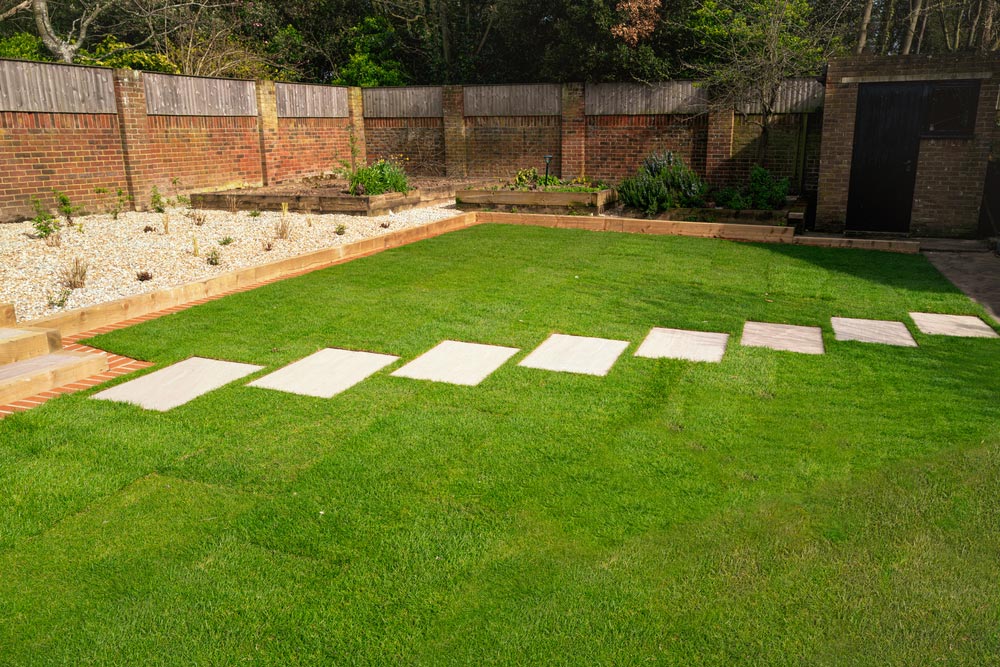When you invest in new turf, you want to ensure it thrives and remains a lush, green feature of your landscape. The journey doesn’t end with installation; proper care is crucial for its longevity and vitality. Whether you’re a new homeowner eager to see your garden flourish or an experienced property owner seeking to keep your turf in top condition, understanding the essentials of turf maintenance is critical. This blog covers everything you need to know, from preparing the soil before installation to watering, mowing, fertilising and managing weeds and pests.

Pre-Installation Soil Preparation
Proper soil preparation is the foundation of a healthy lawn. Ensuring the soil is well-prepared before laying the turf can significantly impact its growth and resilience.
- Assess Soil Quality: Start by testing the soil’s pH level. Turf grows best in soil with a pH between 6 and 7. You might need to amend it if it’s too acidic or alkaline.
- Remove Existing Vegetation: Clear the area of weeds, rocks and old grass. You can use herbicides or manually remove these to prevent them from competing with your new turf.
- Loosen the Soil: Use a rotary hoe or garden fork to break up the soil to a 10-15 cm depth. This helps with root penetration and drainage.
- Level the Surface: Rake the soil to create a smooth, even surface. This ensures good contact between the turf and soil, promoting better rooting.
- Add Organic Matter: Mix in organic compost or a quality soil conditioner to improve soil structure and provide essential nutrients.
The Right Way to Water Your New Turf
Watering is crucial, especially in the early stages of turf establishment. Proper watering ensures deep root growth and a more drought-resistant lawn.
- Initial Watering: Water the turf immediately after installation. Ensure the soil beneath is saturated to a depth of 7-10 cm.
- Frequent Watering: Water daily for the first two weeks to keep the soil moist. Early mornings are ideal as this reduces water evaporation.
- Gradual Reduction: After the initial establishment period, watering should be reduced to 2-3 times weekly. This encourages roots to grow deeper into the soil.
- Check for Signs: Watch for signs of under or overwatering. Wilting or a dull colour indicates a lack of water, while yellowing suggests overwatering.
Mowing Practices for Lush Growth
Mowing is more than just keeping your lawn neat; it’s critical to promoting healthy growth.
- First Mow: Wait until the turf is 6-8 cm high before the first mow, typically around 2-3 weeks after installation.
- Mow at the Right Height: Different grass types have different optimal heights. Keeping the grass at 2.5-4 cm is ideal for most turfs.
- Regular Trimming: Mow regularly, but never remove more than one-third of the grass height in a single mow. This prevents stress on the turf.
- Sharp Blades: Always use a mower with sharp blades to avoid tearing the grass, which can make it susceptible to disease.
Seasonal Fertilisation Strategies
Feeding your turf with the right nutrients at the right time ensures its health and resilience throughout the year.
- Spring: Apply a high-nitrogen fertiliser to boost growth and greening.
- Summer: Use a balanced fertiliser to maintain health during peak growing seasons. Consider slow-release formulas for sustained nourishment.
- Autumn: Transition to a fertiliser with higher potassium to strengthen the turf for winter.
- Winter: Minimise fertilisation during the colder months as growth slows down. Focus on maintaining turf health rather than promoting growth.
Need Help with Turf Installation on the Sunshine Coast?
Maintaining your new turf involves careful attention to detail and a commitment to regular care. At Sunshine Coast Turf, we understand the unique challenges of maintaining Sunshine Coast turf. If you’re ready to transform your outdoor space or need expert advice, get in touch to book a consultation.